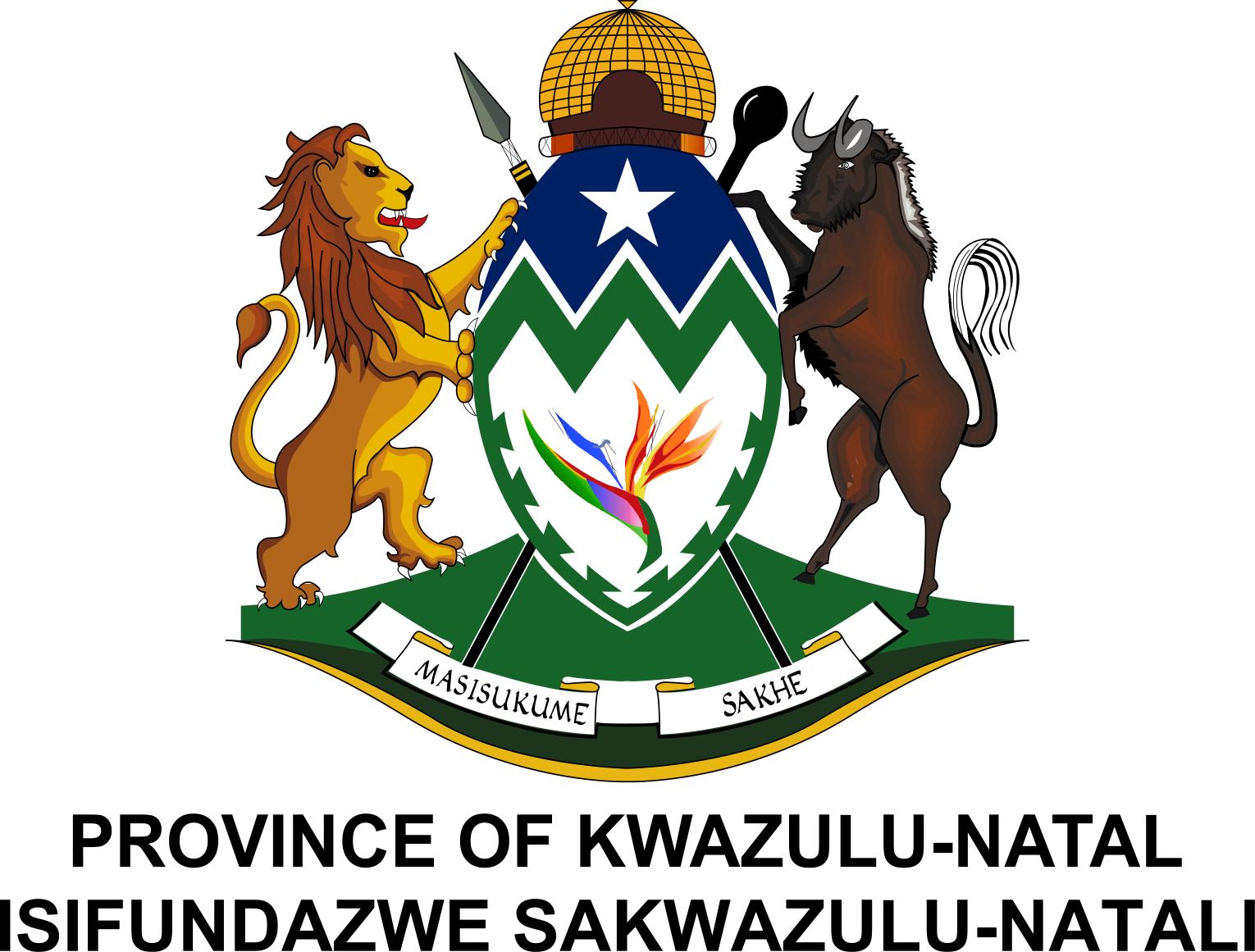
KwaZulu-Natal waited a full decade before adopting a new coat of arms. The blazon has been prepared in both English and isiZulu – the first time any coat of arms has been officially blazoned in South Africa, in any language besides English and Afrikaans.
Arms:
An Nguni shield argent, a strelitzia flower proper, within a border dovetailed and conjoined with a fess dancetty enhanced, both vert; upon a chief azure fimbriated argent, a mullet also argent. Behind the shield an assegai sable, its spearhead proper, and a knobkierie also sable, crossed saltirewise.
Crest:
A beehive hut proper.
Supporters:
Dexter a lion and sinister a gnu proper.
Motto:
Masisikume Sakhe.
Arms explained: The choice of shield shape is highly appropriate: an Nguni shield, reflecting the military traditions of the warrior amaZulu and their predecessors. Its shape is that of two parentheses: ()
Nguni shields have frequently been applied by European heralds in African circumstances, on the grounds that this is an African shield shape, but frequently inappropriately, since the countries for which they have been used either have had entirely different shield traditions – for example Botswana – or have only peripherally been influenced by Nguni invasions.
The shield shape was used by abeNguni long before the time of Shaka, but was then applied to a tall shield at least 2m high, behind which the warrior hid, while long spears were thrown at him.
Shaka's reform abolished both long shields and long spears, replacing the spear with the short stabbing spear or assegai, and reducing the length of the shield to about a metre, so that it was only of use in hand-to-hand fighting.
Even shorter shields, some only 300 mm in height, are traditionally used in stick-fighting, the traditional sport of young Nguni men.
The shield is traditionally made of cowhide, or the skin of some other hoofed animal, and reinforced with sticks. When the shield is not in use, on parade, or in a fighting situation, the sticks are removed for easier carrying.
The sticks are held in place with thongs, which are often in colours contrasting with the rest of the shield. Such thongs can be seen in the Nguni shields, used currently by Gauteng and formerly by KwaZulu, but are absent in this example, as the shield area has been filled with charges in a manner more traditional in the West.
The principal charge is a flower of Strelitzia reginæ, commonly known as the crane flower or bird-of-paradise flower. It is indigenous in the warm valleys of Zululand near the sea, but does not occur naturally in the old Natal Colony south of the Tugela River, although it is found in Transkei and as far south in the Eastern Cape Province as Humansdorp. It is nonetheless widely planted in gardens in Natal, as in other parts of the world – it is officially a symbol of the City of Los Angeles in California – and also grows wild, having seeded itself out of formal gardens.
At least one other species of Strelitzia is also found in KwaZulu-Natal, namely Strelitzia nicolai , which grows to a height of 6m and is easily mistaken for a banana tree – in fact, its common name is Natal wild banana. When it blooms, it cannot be mistaken, since its flowers – at least twice as large as those of S reginæ – are clearly of the same form, although their colouring is cream where the crane flower is orange, and purplish-black where the crane flower is green and blushed.
The crane flower (S reginæ) was the official floral emblem of the Province of Natal.
The fess, with its jagged outline, represents the Drakensberg range – these mountains border the province along its boundaries with Lesotho and the Free State.
Green is the overall colour of the landscape in KwaZulu-Natal.
Crossed behind the shield are an assegai and a knobkierie, both traditional symbols of chiefly authority.
The crest is a beehive hut, the traditional structure used in erecting the homes of the abeNguni. A homestead is generally composed of several such huts, one for the male head of the household, and one for each of his wives and their respective children. Although the amaZulu have largely abandoned this type of hut, they are to be seen in the historic village that has been erected near the site of Shaka's kraal, at Mgingindlovu.
Huts of this type were also typical of the southern Nguni, of what later became Transkei and Ciskei, but the style was largely abandoned in that region about a century and a half ago. An example of the style can nonetheless be seen in the seal of King William's Town, which was the capital of the Colony of British Kaffraria.
The dexter supporter is a natural lion (Leo leo), taken from the arms of KwaZulu, and represents the authority of the Zulu king.
The sinister supporter is a black wildebeest or gnu (Connochætes gnou), a pair of which had been part of the symbolism of the Colony and Province of Natal since 1870, and part of its coat of arms since 1907. In these arms, for the first time, the animal is shown as being rampant, rather than courant (running) – although they are actually blazoned as being in full course at random.
Interim symbol
During the first 10 years of its existence, KwaZulu-Natal used the arms of both Natal and KwaZulu, placed side by side, to represent the province.




